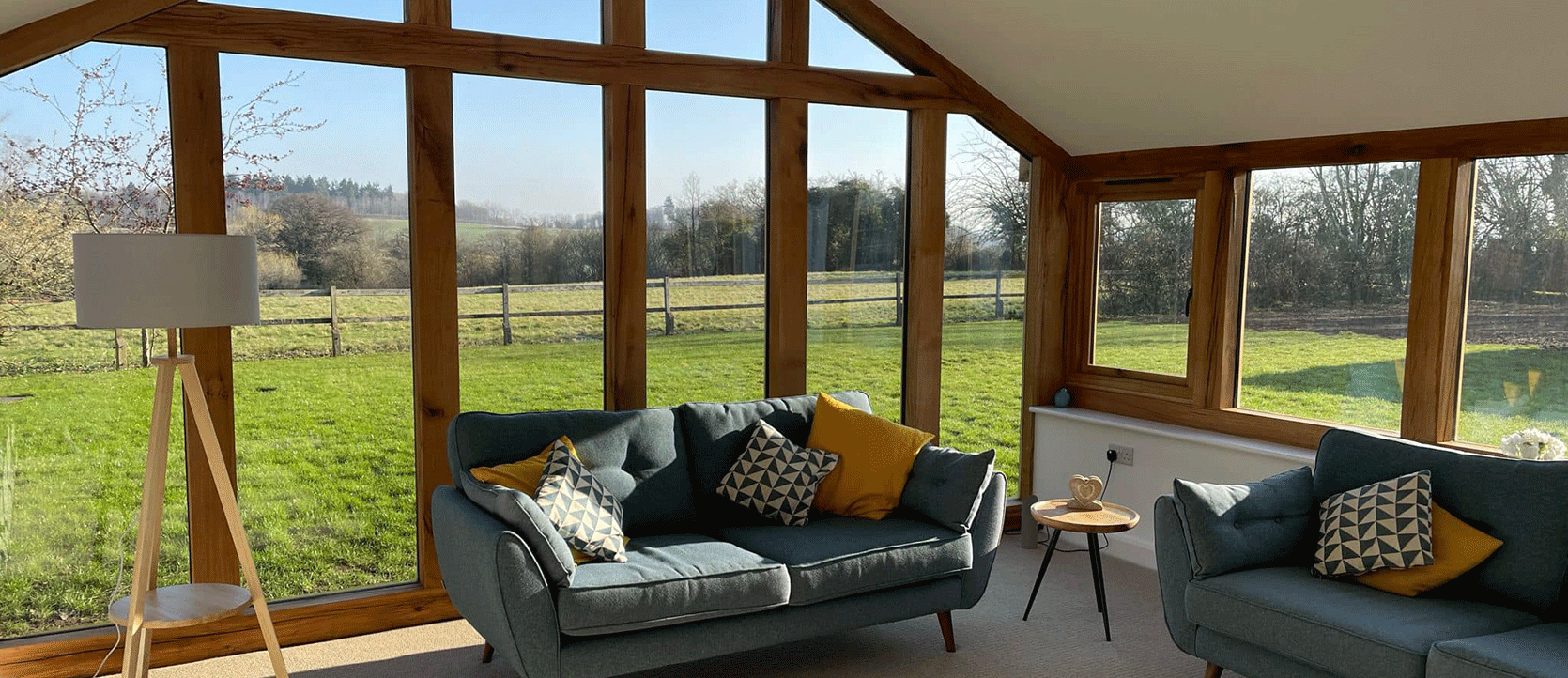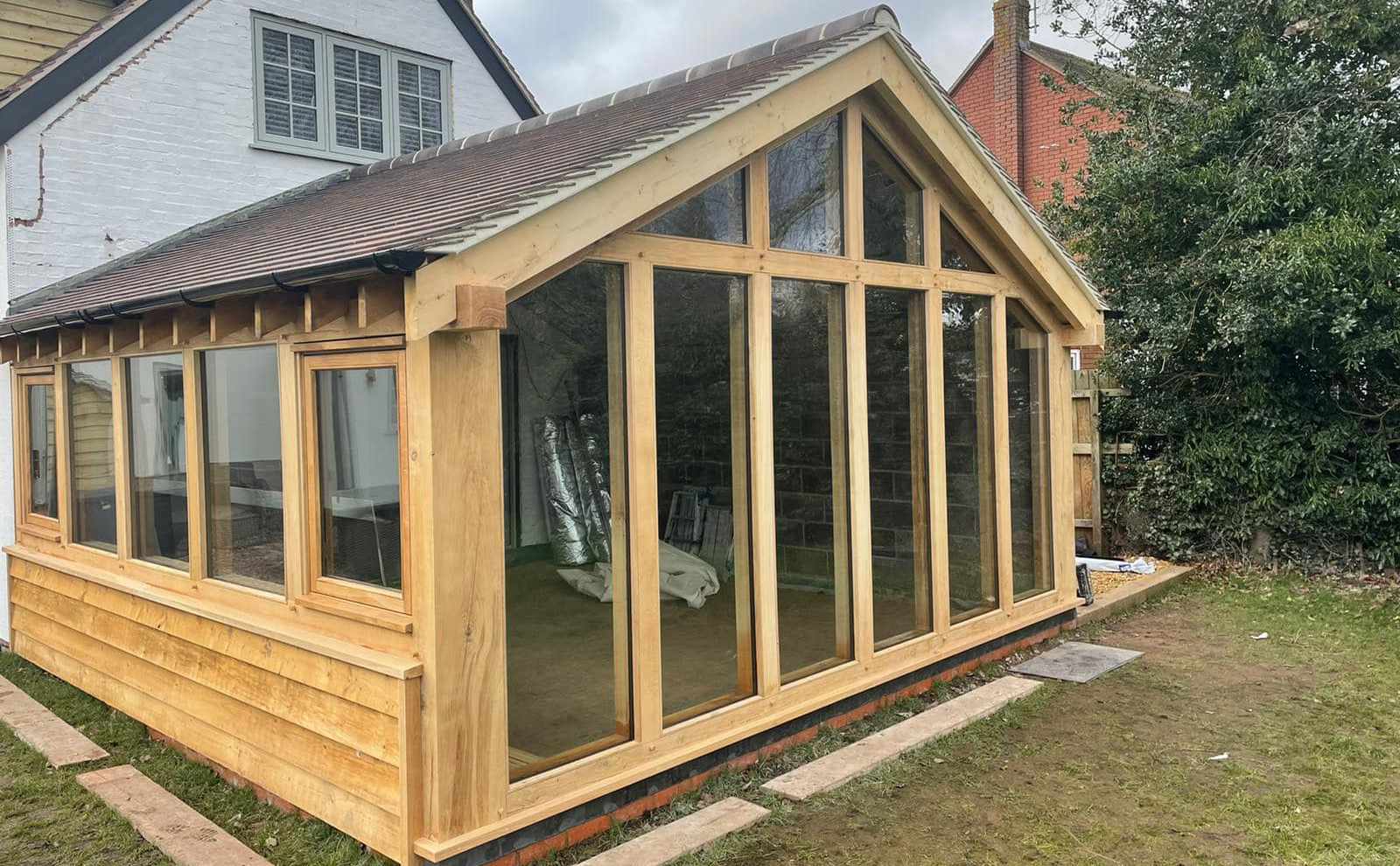Timber Frame vs Brick Extension: The Ultimate Guide
Contents
If you think of a home extension, you most likely imagine a brick-and-mortar structure. But whilst bricks are one of the most common building materials, it is not the only option when extending your home.
Timber frames are fast gaining popularity as a highly aesthetic and valuable building material for extensions which offers the strength and durability of brick.
If you’re unfamiliar with timber frame extensions, you may wonder why you should consider timber as a building material. Isn’t it costly? Won’t it rot?
Our guide to timber frame vs brick extension, complete with an easy comparison table at the end, will answer any questions you may have about timber frame extensions, to help you find the right building material for your home.
It’s important to make an informed decision before you decide on the building material for your extension. The right material for your home extension is one which suits your budget, design preferences, and project timescale.

Timber Frame Extensions
Timber frame extensions, sometimes referred to as wooden frame extensions, are made from either oak or softwood, and provide the framing which bears the load of the extension. This frame is not usually left exposed, so the appearance of a timber frame extension is not dissimilar to a traditional brick extension.
During timber frame construction, in some cases, scaffolding is erected before the timber frame can be installed. Once the frame has been installed, internal stud work is then fitted. The installation of roof trusses and materials begins following this, after which insulation is fitted to the inside of the timber frame. Finally, the outer leaf wall can be built using a material of your choice for the final external appearance of the extension.
Whilst this construction method is once again gaining popularity for both contemporary and traditional builds, it is not a new construction method – timber frame buildings have long stood the test of time and offer many advantages to home owners.
Advantages of Timber Frame Extensions
There are many advantages to using timber frames for your extension.
Speed of construction. One of the main advantages of timber frames is how quickly the extension can be built. Because the majority of work in creating the timber frame is undertaken offsite, it means installation on site happens much quicker.
Whilst the build of the frame is happening offsite, additional work such as ground work can be completed on-site and ready for the installation of the frame. Plus, the foundation for oak frame extensions do not have to be as deep as brick extensions, saving time during this stage also.
Flexibility of design. Timber house extensions offer greater design flexibility than brick extensions. With timber frame, a number of design possibilities can be achieved: exposed beams; unique ceiling designs; and a number of cladding materials including timber, brick, stone and render so the external appearance is suited to your home. This is possible for all size extensions, ensuring your extension complements your home and realises your visions.
Adding a wooden extension to a brick house can create a beautiful contrast that adds visual interest and texture to the overall design. The blend of traditional brick and natural timber can give the home a modern and unique appearance.
Cost. Timber frame extensions can be more economical in the long run compared to brick extensions. Whilst there is a higher upfront cost, the faster construction process reduces labour costs. The majority of your budget for a brick extension will contribute towards labour expenses, yet with timber your cost is put towards the quality and value of material. You will have greater cost control and certainty throughout the build because of the expenses being upfront.
Environmental impact. There is also the reduced environmental impact of using timber rather than brick-and-mortar. When sourced from a sustainably managed forest, timber is replaceable; less waste is produced when using timber; and it also has a reduced environmental impact when processing and transporting compared to brick-and-mortar.
Disadvantages of Timber Frame Extensions
Like with any material, there are some disadvantages to building with timber. One of these disadvantages includes noise transfer.
Noise transfer. One of the disadvantages of timber frame extensions is the transfer of noise. Because brick is much denser than oak, noise is better insulated with brick. This may not be a problem if you’re located in a quiet area, or noise transfer isn’t a problem to you. Timber can also be made more soundproof by creating a structural break between the internal and external wall and fitting insulation.
May require maintenance. Compared to brick, timber extensions may need painting or staining to protect against the elements. We’ve written a whole article about the importance of oak treatment, take a look by clicking the link.
Less choice of suppliers. Due to the specialised nature of timber frame construction, fewer suppliers offer materials and services tailored specifically for this type of extension. Enville Oak stands out as a reliable supplier with extensive experience working with homeowners, architects and contractors. Our reputation is supported by positive customer testimonials and a strong portfolio of completed projects.

Brick Extensions
During brick-and-mortar extensions, raw materials will be delivered and constructed on site, where the foundation for the extension should have already been dug out, ready for the construction stage.
There are a variety of bricks to choose from, so you can find the right aesthetic and properties for your build.
Masonry experts will then build the extension following specific design drawings.
Brick extensions are one of the most popular extension types, with many advantages, including…
Advantages of Brick Extensions
Some of the advantages to using brick as your construction material are as follows.
Long-lasting and durable. Brick is a dense material which offers durability and a long lifespan, maintaining its aesthetic over time. If anything does happen to your extension, brick is also easy to repair and replace.
Classic and timeless appearance. Brick is one of the most prominent building materials, so you can be sure that its aesthetic won’t go out of fashion anytime soon. It is likely to be approved for planning permission because of this, since it is not a controversial style and will blend well with the surrounding buildings.
Resistance to the elements. Brick offers good resistance to heat and fire as well as wind, rain and snow. Bricks can absorb and slowly release heat without damaging its properties, increasing the natural insulation of your extension. They hold up well in the British weather – remaining durable in wind, rain and snow, with the ability to release moisture through transpiration so it doesn’t build up in the material.
Disadvantages to Brick Extensions
Some considerations of brick extensions include its construction time, design, and cost.
Longer construction time. Brick-and-mortar is known as a wet trade; during the construction of a brick extension, you must account for drying time as the mortar sets. The construction process takes place on-site, which can extend the length of construction and risks delays due to wet or bad weather conditions.
Limited flexibility in design. Whilst there is a variety of bricks available to buy, brick is somewhat limited in its construction design and does not offer the creative freedom as timber does. Matching your new extension bricks with your existing house bricks is also extremely tricky, which could pose some aesthetic issues.
Cost. The cost of a brick extension can soon add up. Masonry and labour fees, due to lengthier construction processes, often result in higher fees than timber frame extensions.

Timber Frame vs Brick Extension
Still undecided about which building material is right for your home extension?
Take a look at the comparison table below for a clear picture of the properties of timber vs brick.
| Timber | Brick | |
| Cost | Larger upfront cost to purchase materials, however shorter construction process means reduced labour fees. | Less expensive to purchase upfront with a greater choice of suppliers. However, it can be more expensive than timber due to increased labour costs. |
| Speed of Construction | Timber is largely constructed offsite, which results in a shorter construction process onsite. | Brick must be constructed onsite; this process can be delayed due to weather conditions and unforeseen circumstances. |
| Flexibility in Design | Timber extensions offer flexibility in design, with beautiful and unique creations achievable. | Brick offers some flexibility in design, although this is more limited compared to timber. |
| Energy Efficiency | Timber, especially oak, is a naturally insulating material thanks to air pockets in the wood. This increases energy efficiency. | Brick is a dense building material so is naturally insulating; however, it is not as naturally insulating as oak. |
| Maintenance | Timber, namely oak, is a low-maintenance material with natural resistance to rot, fungal infection and pests and insects; it doesn’t need any additional treatment. | Brick is also very low maintenance; it maintains its aesthetic over time and offers resistance to heat, rain and snow without additional treatment. |
| Sustainability | Timber sourced from responsible forests is a renewable material; any waste created can be repurposed; and it has less of an environmental impact during sourcing and processing stages. | Brick is a raw, finite material which cannot be replaced. Sourcing and processing can be intensive, resulting in a larger carbon footprint. |
| Aesthetics | This is dependent on personal preference. Timber offers a warm and natural aesthetic, which is unique and value-adding. | Brick offers a more traditional and conventional aesthetic which blends well with existing buildings. |
When deciding on timber frame vs brick extension, decide on which factors are a priority for your build. If a shortened onsite construction time is important to you, without detracting from quality and durability, timber frame extensions may be the solution for you. If you’re looking for lower upfront costs and a more conventional aesthetic, brick is a great material to achieve this with.
We recommend talking to both timber construction experts and masonry professionals to see which material works best for you.
Interested in this article? Read others like it...